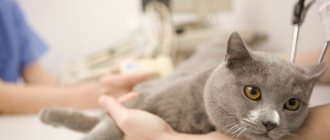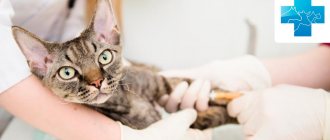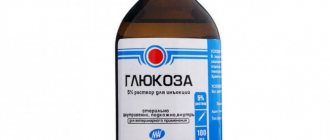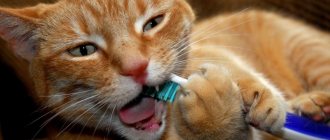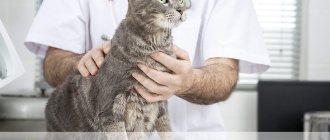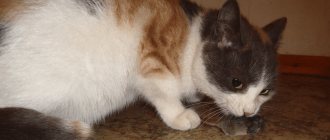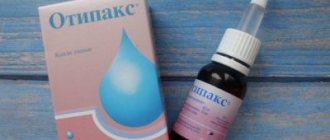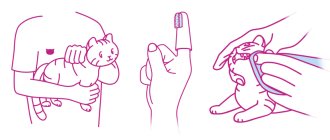Signs of inflammation of the paraanal glands in a cat. Basic methods for cleaning the anal glands. Paraanal abscess as a complication of the inflammatory process.
You can listen to this article in full on our podcast:
Paraanal glands are paired organs that are located in the cat's anus. Their main function is the release of sexual secretion, which has a semi-liquid consistency and a specific odor.
These glands are located at 5 and 8 o'clock on the clock dial in relation to the circumference of the anus.
These glands are necessary for marking territory in mature individuals.
In felines living in their natural habitat, they serve for self-defense (the secret is released in life-threatening situations).
Normally, in domestic and wild animals, the paraanal glands are emptied during defecation.
Watch the video: Why clean anal glands in cats
When do cats and dogs need to have their anal glands cleaned?
Usually these glands are completely cleared when stool is released. This is a natural process and there is no need to interfere with it.
But in some cases they can become clogged, and then the normal removal of secretions from the pet’s body is disrupted. If the bags are overfilled, the well-being of the “tail” deteriorates sharply. In such a situation, an urgent visit to a veterinarian is necessary. If treatment of the inflamed organ is not started in time, pathogenic bacteria begin to multiply in it. An infection gradually develops, which can result in suppuration.
The most common causes of blockage of the paraanal glands are:
- inflammatory process;
- genetic factor;
- diseases of the digestive system;
- constipation;
- helminth infection;
- infection;
- improperly formed dog diet with a predominance of protein foods or bones;
- lack of hygiene;
- weakening of the body's defenses.
Most often, the problem with gland blockage occurs in pets of small breeds (pugs, Pekingese, dachshunds, Shih Tzu, Spitz, etc.) They move too little, which is why their feces soften significantly, disrupting the normal process of bowel movements. Most often the disease affects pregnant and lactating females.
How to understand that the anal glands are full
The main signs of overflow of the paraanal glands in dogs and cats are pain and discomfort, so the owner needs to pay attention to the pet’s behavior. If an animal constantly bites its hind legs, frequently licks its anus, tries to catch its tail, or rubs itself on the floor, you should show it to a specialist. Symptoms of blockage of the paraanal glands are also a fishy smell emanating from the tail, redness of the anus and difficulty defecating. As the disease progresses, an abscess sometimes develops, from which blood and pus flow out upon opening.
In total, there are four stages of blockage of the paraanal glands:
- The total amount of secretion decreases sharply, and the pet begins to experience severe itching.
- The liquid inside the sacs thickens greatly, causing it to become compacted. At this time, spasms of the animal’s hind legs are often observed.
- The secretion of the gland stops draining naturally. An infection develops, followed by inflammation. Your pet may experience acute pain when defecating.
- The duct is completely blocked, and the pet develops an abscess of the paraanal gland. His body temperature rises and his general health deteriorates significantly.
Causes of discharge from the anus
Discharge in a cat during diarrhea or constipation is quite normal and quite common. They manifest themselves in different ways, but are fairly easy to identify, so they are not too dangerous. The owner may also notice a small amount of blood clots in them. This symptom disappears completely with complete recovery. Therefore, you should not worry too much about this.
But if the discharge from either the anus in a cat or the vaginal area in a cat is purulent or mucous in nature and has a characteristic odor, we can talk about the presence of an infection.
Often this can be associated with problems with the genital organs of cats. But there are other options that require careful testing, special tests and smears. Here you should seek the help of a specialist as soon as possible so as not to aggravate the situation and alleviate the cat’s suffering.
© shutterstock
Often the cause of discharge from the anus is inflammation of the paraanal glands. Previously, many were inclined to think that such problems were directly related to the abundant use of dry food in the diet of pets. However, it turned out that this is a myth. Often, discharge appears due to the unusual structure of the intestine itself. For example, you may notice frequent attempts by the animal to sit on its hind legs or walk along the floor. Such manifestations of attempts to get rid of excess secretions should be immediately noticeable to the owner.
Is it possible to check on your own whether your pet’s sinuses are blocked?
When the anal sinuses are in normal condition, they are empty and feel soft to the touch. You should wear sterile rubber gloves and carefully insert your finger into the anus and examine its walls in search of seals.
Of course, this is not the most pleasant procedure for both the owner and the pet. And if you are not a professional, you can press too hard and harm your pet’s health. Therefore, it is better to consult a doctor or grooming specialist.
What happens if you do not contact a veterinarian in time if there is a pathology?
Don't think that the problem will solve itself. As we have already said, the accumulated secretion in the anal sacs becomes an excellent breeding ground for the proliferation of pathogenic bacteria. If clogged anal glands are not cleared, your pet will require lengthy and complex treatment.
Signs of a worsening situation are:
- pain experienced by the pet during bowel movements (he may whine, grunt, etc.);
- hair loss;
- redness of the tissues near the anus;
- wet areas;
- presence of fistulas;
- swelling in the anal area;
- presence of irritation, etc.
In such cases, the animal needs urgent help from a specialist. You cannot clean the anal glands yourself!
Treatment of the inflammatory process
Treatment of inflamed paraanal glands should only occur in a veterinary clinic under the supervision of a physician after a thorough examination and assessment of the severity of the lesion.
Therapy involves cleaning, rinsing or removing the affected glands.
Cleaning
At the initial stage of the disease, cats undergo cleaning of the paraanal glands. Depending on the consistency of the accumulated secretion, this procedure can be carried out in the clinic or at home by a visiting veterinarian or an experienced breeder. In any case, cleaning brings discomfort to cats, so it will be more convenient to do it together.
Before cleaning the glands from accumulated secretions, it is necessary to palpate them to determine the consistency of the contents.
If the secretion is liquid, you can clean it yourself using an external method. The animal should be secured, the inflamed glands should be covered with a napkin and their contents should be carefully squeezed out - to do this, you need to squeeze the sides of the anus with two fingers and squeeze.
If a liquid with a very pungent and unpleasant odor appears, the procedure can be considered successful. At the end of the manipulation, the anal area must be treated with Chlorhexidine.
If the contents of the glands are dense, the procedure should only be performed by a doctor, since the cat will need internal cleaning, which is called the rectal debridement method. In such a situation, the index finger is inserted into the animal’s rectum, the outside is felt with the thumb and the contents are gently squeezed out. At the end of the procedure, the anus is treated with an antiseptic solution, and ¼ of an anti-inflammatory suppository is inserted inside.
Important! It is forbidden to clean cats that do not have inflammation of the paraanal glands, since such intervention can lead to disruption of their normal functioning.
Washing
Washing should be carried out exclusively by a veterinarian in a clinic setting. This procedure is indicated in the most severe cases, when a fistula or abscess has formed, and other methods do not bring results.
First, the cat's anal glands are cleaned mechanically. Then, under local anesthesia, a solution of potassium permanganate, Chlorhexidine or another antiseptic is injected into the anus using a catheter or syringe without a needle.
The procedure must be repeated several times until the flowing liquid becomes clear. This will indicate that there is no thick secretion or pus left in the paraanal glands. Next, the cat is given rectal anti-inflammatory suppositories, and the outside of the anus is lubricated with antiseptic ointment.
Important! Depending on the severity of the disease, the animal may also be prescribed antibiotic therapy.
Removal
In the most severe cases, when it is no longer possible to clean and washing does not bring results, veterinarians remove the paraanal glands from cats. Doctors also recommend this operation for pets who constantly suffer from blocked ducts.
Regular cleaning is a significant stress for cats, so removing the anal glands will make life easier for both owners and their pets.
The removal operation is performed under general anesthesia. The doctor makes 2 small incisions in the area where the anal glands are located, removes them along with the ducts and applies sutures. In the future, the owners need to treat the wound with a healing preparation, and also give the cat vitamins for speedy skin regeneration and antibiotics (if indicated, for 5–7 days).
Important! Owners need to ensure that the cat does not become constipated until the stitches heal. Otherwise, they may separate.
Appointment with a veterinarian in advanced cases
The doctor will examine your pet and prescribe the necessary tests. Usually a general blood test is required, but sometimes the contents of the anal glands and skin scrapings are also taken for analysis.
Based on the research results, the specialist will determine a treatment regimen and give the owner recommendations for treatment and prevention of relapse of the disease.
Usually it is enough to thoroughly clean and rinse the glands, treat the surrounding tissues with disinfecting compounds, and then give the pet a course of therapy with antibacterial and painkillers. To prevent infection in the postoperative area, a veterinary collar is placed on the pet’s neck.
Deep cleaning of the glands is carried out without general anesthesia using local anesthesia. The patient is immobilized and the procedure is carried out carefully.
If the inflammatory process has progressed far and complications have arisen, drainage may need to be installed or surgery to remove the anal glands.
Dogs should be taken for walks more often during treatment. Any abstinence from bowel movements can cause constipation and impair tissue healing.
The owner also needs to provide the pet with a special diet of fiber-enriched, easily digestible foods. Ideally, make an appointment with a veterinary nutritionist.
Symptoms of inflammation
Symptoms of anal gland inflammation should be taken seriously.
- The cat drags its rear end along the ground.
- Excessive licking or biting of the anal area, base of the tail.
- Frequent tail chasing.
- Painful bowel movement.
- Excessive straining during bowel movements.
- Unpleasant smell.
- Red, swollen and painful anal area.
- Increased aggressiveness.
If you see these signs, take your cat to the vet. The doctor will perform a rectal exam and order tests if he thinks your cat may have an infection or tumor.
Call a veterinarian Moscow
+7(495)162-70-70
Prevention of disease after treatment
You need to visit a veterinarian at least once every six months. The anal glands should be cleaned only when indicated. The groomer or doctor will first conduct an examination, and only if the presence of blockage of the paraanal glands is confirmed, will he carefully empty the sinuses.
Other equally important methods for preventing sinus blockage are:
- fight against excess weight, if any;
- deworming;
- taking care of your pet's hygiene;
- tracking the frequency of his bowel movements;
- intensive walks with dogs or active games with cats;
- regular feeding of a balanced diet.
If you follow all the doctor’s recommendations, the animal’s intestines will begin to empty normally. The pet's condition will remain stable and no additional cleaning will be required. Feces passing through the anus will put pressure on the paraanal glands, and secretions from the sacs will freely release into the external environment during defecation.
Preventive measures
To avoid having to treat inflammation occurring in the anus, it is recommended to carefully monitor the pet’s condition. If the cat is not able to clean the anal glands on his own, then this procedure is performed by the owner or in a veterinary clinic. It is important to give your pet healthy food that does not contain bones or other large elements, so that constipation does not occur and the functioning of the gastrointestinal tract is not disrupted. It is worth strengthening the immune system by consuming vitamins and beneficial microelements. The anal glands are less likely to become inflamed in cats that exercise enough and regularly play active games.
Is it necessary to clean the paraanal glands of a pet just like that, for prevention?
No: the process of secretion extraction should normally proceed without outside interference. Any pressure on the sinuses and artificial emptying of the glands without medical indications can only cause harm. It is strictly forbidden to interfere with natural processes if they proceed normally without pathologies.
Our specialists carry out cleaning only when necessary, which is communicated to the owner after the examination and/or procedure.
Owners need to know about the existence and principles of operation of the paraanal glands in order to promptly suspect irregularities in their work and promptly seek advice. We categorically do not recommend mechanical cleaning without indications.
